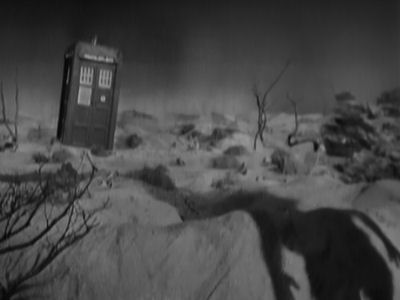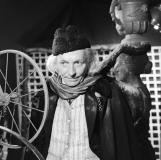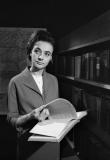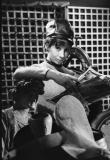An Unearthly Series - The Origins of a TV Legend
Thursday, 19 September 2013 - Reported by Marcus

 The twentieth in our series of features telling the story of the creation of Doctor Who, and the people who made it happen.
The twentieth in our series of features telling the story of the creation of Doctor Who, and the people who made it happen.With the first scripts now complete and work well under way on the titles and music for the new series, the cast and crew began the start of the long process of turning the thoughts and ideas of the production team into a television play.
It was on Thursday 19th September, exactly 50 years ago today, that the first dramatic filming for an episode of Doctor Who took place.
 In the days before video editing, complicated sequences, or items that required a lot of setting up, would always be recorded on to film. Film was a much more flexible medium than video tape, primarily because it could be easily edited.
In the days before video editing, complicated sequences, or items that required a lot of setting up, would always be recorded on to film. Film was a much more flexible medium than video tape, primarily because it could be easily edited. Film was also used for sequences that needed a large set, one that would not be practical in the confines of a television studio. It was used for sequences that would not be allowed in an electronic studio, such as those involving fire or water.
The downside of film production was the cost. It was more expensive than video recording and took much longer to produce. Camera set-ups and lighting took time and sequences had to be repeated many times to get the required shots. Film then had to be developed and edited before it was transmittable.
Any film sequences needed to be complete before the studio session took place in the electronic studio, as film insets needed to be played through the studio, in real time, to become part of the complete recording. For the first episode of Doctor Who just one film sequence was needed: the shot at the very end of the episode when the TARDIS is seen having landed in prehistoric times, being overlooked by the shadow of a human.
One actor was required for this, and Leslie Bates provided the shadow of the caveman overlooking the TARDIS after it had landed, thus becoming the first actor to have his image recorded for Doctor Who, albeit only as a shadow and uncredited.
The following day, the four principal cast members met at BBC Television Centre at 3pm to take part in a photocall for Radio Times. A small mock-up of the junkyard set and the classroom had been rigged, and it was hoped by the production team that the series would be awarded the cover of the relevant Radio Times, but this was not confirmed.
It was the first time the four cast members had met, and Carole Ann Ford remembers her feelings on the day:
I was very much in awe of William Russell, having seen him in many productions, and he was so dishy.
I thought that Jackie seemed terrifying. I learnt later that she was very shy and whenever she was in a situation where she was uneasy she just went a bit rigid. It made her look a bit awesome.
Bill I liked immediately, and we got on terribly well.
I thought that Jackie seemed terrifying. I learnt later that she was very shy and whenever she was in a situation where she was uneasy she just went a bit rigid. It made her look a bit awesome.
Bill I liked immediately, and we got on terribly well.
The next day, on Saturday 21st September 1963, that first TARDIS team met in a West London hall, where they would begin the very first rehearsals for the very first episode of Doctor Who.
The location was the Drill Hall at 117 Walmer Road, London, W2. The part of Walmer Road where the local Territorial Army base once stood no longer exists. The street was split in half during the late-1960s to allow a new housing project to be built, and the location where those first tentative rehearsals took place - and where Doctor Who was first brought to life - now lies in Kingsdown Close, the site occupied by a block of flats sandwiched between the Hammersmith and City Underground Line and the Westway.
Recording Television
Television dramas in the 1960s were either transmitted live or recorded as live.
Video technology had developed to a point where shows could be recorded on two-inch-wide magnetic tape. However, editing ability was very limited and had to be done by physically cutting the unwanted material from the magnetic tape and splicing the two ends together.
A microscope was used to examine the tape to ensure the cut was done at the correct point of the electronic signal or else the picture would "roll". Because of the high cost of the raw materials there was a great reluctance to cut the tape, as it was intended that once the show had been broadcast the tape would be recycled and used again.
Any drama had to be recorded in as near to real time as possible. Although it was accepted that a drama as complex as Doctor Who would need some recording breaks, these were very limited and had to be agreed with the programme's producer. A thorough rehearsal of each episode was needed to ensure that each recording proceeded as seamlessly as possible. Television dramas in the 1960s were either transmitted live or recorded as live.
Video technology had developed to a point where shows could be recorded on two-inch-wide magnetic tape. However, editing ability was very limited and had to be done by physically cutting the unwanted material from the magnetic tape and splicing the two ends together.
A microscope was used to examine the tape to ensure the cut was done at the correct point of the electronic signal or else the picture would "roll". Because of the high cost of the raw materials there was a great reluctance to cut the tape, as it was intended that once the show had been broadcast the tape would be recycled and used again.
Waris Hussein
This was a show that everybody didn't quite know where it was heading. They thought this was the beginning of something where we don't quite know where it's going to go, so we all sat down with a certain sense of occasion.
This was a show that everybody didn't quite know where it was heading. They thought this was the beginning of something where we don't quite know where it's going to go, so we all sat down with a certain sense of occasion.
William Russell
You only had four days. We had to get on with it. It was moving fast all the time.
While the cast were establishing their characters, decisions were being taken on the running order of the series. By mutual consent, David Whitaker and Anthony Coburn agreed that Coburn's story The Robots should swap places in the series running order with the Terry Nation story, originally planned to be fifth in the series run. The main reason was that the scripts for The Robots were still not finished, while Nation's scripts were ready. Design work needed to be started on the story. You only had four days. We had to get on with it. It was moving fast all the time.
Looking much further forward, it was now decided to complete the first year's run with two seven-part stories and one four-part story. Nation was commissioned to write one of the seven-part stories, The Red Fort, which would be set during the Indian Mutiny.


SOURCES: Doctor Who: Origins. Richard Molesworth. The Beginning. DVD Box Set. BBC Worldwide; The Handbook: The First Doctor – The William Hartnell Years: 1963-1966, David J Howe, Mark Stammers, Stephen James Walker (Doctor Who Books, 1994)






















